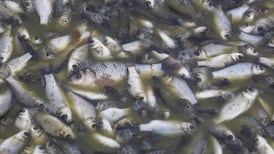A major fish kill has been discovered in Lady's Island Lake, Co Wexford, and is being investigated by the Environmental Protection Agency (EPA).
Thousands of fish, including eels, herring, plaice, flounder, bass and mullet have been destroyed in the shallow water which is like an estuary blocked off from the sea by a sand barrier.
The kill was reported to the Eastern Regional Fisheries Board. Mr Donnachadh Byrne, environmental officer, said it seemed to be an oxygen problem.
He said the lake had serious water problems in the past. The EPA had tested it over the years.
"We went out last Thursday and found a large number of dead fish. It does look like a complete kill and it's safe to say the figure would run into the thousands," he said.
He said the water was examined and it was quite polluted. The high temperatures and sunny conditions had made the water temperature rise. Tests showed the temperature in the water was 24 to 25 degrees, which was quite high.
Other tests revealed that the oxygen level was half what it should be. There were algae and plant material also present.
Mr Byrne said there was a lot of commercial eel fishing carried out on the lake. People had bought eel netting licences. "The eels are exported and are a very valuable commercial commodity, more than salmon. I'd be very surprised if there are any eels left," Mr Byrne said.
Eels and herrings were the biggest components of the kill. Local people usually cut a break in the sand barrier in winter to let water out and also allow young fish to come in from the sea.
It would not be until then that stocks could build up again, he said.
Mr Byrne said there was a fish kill in the same area in 1998.
An EPA spokeswoman confirmed that the agency was carrying out an investigation into the kill and had already taken water samples. The agency would be monitoring the oxygen in the water over the next two weeks, she added.
An environmental group called Friends of the Irish Environment said the lake also hosted numerous internationally protected bird species and called for a full study of the ecology of the lake.








